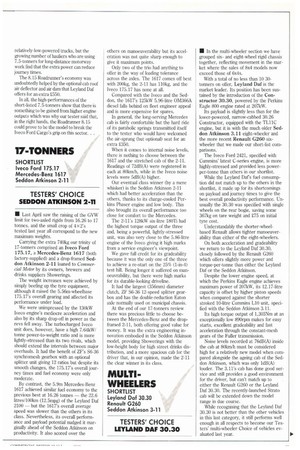UP TO 7,5 TONNES
Page 32

Page 33

If you've noticed an error in this article please click here to report it so we can fix it.
SHORTLIST AWD TL8-14 dropside Leyland Daf Roadrunner 8.15 boxyan MAN-VW 8.150F curtainsider
TESTER'S CHOICE ROADRUNNER 8.15
• Are engine outputs of 100kW (134hp) and more really justifiable at the 7.5-tonne threshold? Our testers' choice is a clear "yes". All three finalists have engines rated at between 103 and 110kW (138-147hp), which are extremely fuel efficient into the bargain, so their productivity is high.
In recent years Cargos and Roadrunners, which currently take first and second place in this market sector, have battled it out for class supremacy in our Tester's Choice, but last year Iveco Ford failed to provide us with a comparable 114kW 0815 7. 5-tonner.
We did manage to test a 94kW boxbodied Cargo 0813 some 10 months ago but the engine output gap left it too far behind the top three on productivity.
A similar lack of power (and a 220,750
price tag) were also the main reasons behind the elimination of Volvo's enigmatic FL4 with its high-revving 82kW 3.59-litre TD41G turbocharged engine.
Top of our final list (but only alphabetically) is the drop-sided TL 8-14 from Bedford's successor, AWD, followed by a Whitbread-owned MAN 8.150F with a Don-Bur Slide-a-Side body but our clear-cut choice for 1989 is Leyland Dal's 8.15 Roadrunner, complete with a Boalloy Seven-5-Liner box body.
Outwardly, AWD's 8-14 still resembles the old TL model, but Perkin's 107KW six-litre turbocharged Phaser engine churns out 20% more torque than its 5.6-litre GM Red-Series predecessor and is much more flexible as a result. It had the better fuel consumption return, but once its marks had been adjusted to account for the difference in body heights, it was the Roadrunner that led on productivity with the TLS-14 second, closely followed by the powerful MAN 8.150F.
The AWD's conventional air-overhydraulic drum brakes provided better stopping power than the MAN's full-air system, but had to share top marks with the front-disc-braked 8.15 Roadrunner.
The TL 8-14 with its 3.84m wheelbase was the only one to achieve a 30% (1-in-3) restart and costs about 2500 less than the others, but from there-on in, it started to lose its edge.
We found the 3.1m-wheelbase MAN to have ■ust a better loading tolerance across the axis; a slight advantage on payload; and, with crisper acceleration and tighter tura;mg circles, the 8.150F looks to be everything a brewery would want for urban deliveries.
Nonetheless, there is no mistaking the value of the Leyland Daf 8.15, despite being, on paper, the lowest powered of the three finalists. The 3.65m-wheelbase model came out tops on performance and, with its 3.57-tonne payload, nudged the others aside to gain the best marks in productivity.
In addition to being close behind the stubby MAN on manoeuverability and acceleration, the Roadrunner's Cummins B-series, with its slightly shorter stroke, is the most lightly stressed of the three engines, which will enhance its durability and longevity.
The Roadrunner's cab is the quietest and most modern of the three, especially when blessed with the optional QX trim package. Noise levels range between 69 and 74dB (A) at speeds up to 96km/h; this is 3dB(A) less than the MAN and 4db(A) quieter than AWD's revamped TL cab. Much of the 8.15's sound damping is due to the optional fitted-carpets. At £700 the QX package, which includes matching curtains, cab trim, Isringhausen air-suspended driver's seat and a radio/cassette player, makes the cab particularly attractive, especially to ownerdrivers and small fleet owners.
We believe there are inter-urban operators who save money by sticking to relatively-low-powered trucks, but the growing number of hauliers who are using 7.5-tanners for long-distance motorway work find that the extra power can reduce journey times.
The 8.15 Roadrunner's economy was undoubtedly helped by the optional cab roof air deflector and air dam that Leyland Daf offers for an extra 2550.
In all, the high-performances of the short-listed 7. 5-tonners show that there is something to be gained from higher engine outputs which was why our tester said that, in the right hands, the Roadrunner 8.15 could prove to be the model to break the Iveco Ford Cargo's grip on this sector. . .
































































































